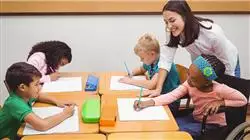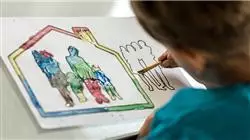University certificate
The world's largest faculty of education”
Introduction to the Program
Acquire new knowledge in your daily practice based on experiences and highly complex cases”

There are several types of social exclusion in the educational environment, and they can be produced by the students' economic level, their physical condition, appearance or some special nature that differentiates them from the rest. That is why the role of the educator plays a fundamental role in the classroom, not only to instruct students in the most correct way, but also to identify the influential factors that generate this type of discrimination. This is why, given this need, a series of practices focused on individual and collective capabilities must be used to generate a better educational environment. In view of this, TECH has created this program in order to broaden the current panorama and modernize the guidelines imposed by the sector years ago.
This leads to the design of the Postgraduate diploma, in which the professionals will find a conglomerate of updated knowledge based on the most recent cases of social exclusion. Therefore, aspects such as cooperative learning, group work and coeducation will be deepened. In addition, by using a methodology based on the simulation of real cases, the teachers will acquire new resources and pedagogical dynamics, which will lead them to implement procedures that contribute to the reduction of marginalization.
All these tools provided in the program will be presented in innovative audiovisual materials, as well as complementary readings and activities focused on day-to-day situations. Students will be able to access these resources in the virtual campus and, in the same way, they will be able to download their content in order to consult it as many times as they need. In this way, the academic demand with which the program has been developed is evidenced and an immersive experience is guaranteed.
The Relearning system applied by TECH in its programs reduces the teaching load and focuses on the most relevant aspects for the sector”
This Postgraduate diploma in Detection of Social Exclusion in the Educational Environment contains the most complete and up-to-date educational program on the market. The most important features include:
- The development of case studies presented by experts in inclusive education for children and adolescents
- Graphic, schematic, and practical contents with which they are created, provide scientific and practical information on the disciplines that are essential for professional practice
- Practical exercises where the self-assessment process can be carried out to improve learning
- Its special emphasis on innovative methodologies
- Theoretical lessons, questions to the expert, debate forums on controversial topics, and individual reflection assignments
- Content that is accessible from any fixed or portable device with an Internet connection
You will have at your disposal a program nurtured with the most recent updates in the educational sector, so you will learn new methods and pedagogical practices”
The program’s teaching staff includes professionals from the sector who contribute their work experience to this educational program, as well as renowned specialists from leading societies and prestigious universities.
Its multimedia content, developed with the latest educational technology, will provide the professionals with situated and contextual learning, i.e., a simulated environment that will provide an immersive education programmed to learn in real situations.
The design of this program focuses on Problem-Based Learning, by means of which the professionals must try to solve the different professional practice situations that are presented throughout the academic course. For this purpose, the students will be assisted by an innovative interactive video system created by renowned experts.
The virtual campus will be at your disposal 24 hours a day, so you can consult the content of the program at the time that best suits you"

Download the syllabus to your daily device and have it at hand to study it in depth whenever you need it"
Why study at TECH?
TECH is the world’s largest online university. With an impressive catalog of more than 14,000 university programs available in 11 languages, it is positioned as a leader in employability, with a 99% job placement rate. In addition, it relies on an enormous faculty of more than 6,000 professors of the highest international renown.

Study at the world's largest online university and guarantee your professional success. The future starts at TECH”
The world’s best online university according to FORBES
The prestigious Forbes magazine, specialized in business and finance, has highlighted TECH as “the world's best online university” This is what they have recently stated in an article in their digital edition in which they echo the success story of this institution, “thanks to the academic offer it provides, the selection of its teaching staff, and an innovative learning method aimed at educating the professionals of the future”
A revolutionary study method, a cutting-edge faculty and a practical focus: the key to TECH's success.
The most complete study plans on the university scene
TECH offers the most complete study plans on the university scene, with syllabuses that cover fundamental concepts and, at the same time, the main scientific advances in their specific scientific areas. In addition, these programs are continuously being updated to guarantee students the academic vanguard and the most in-demand professional skills. In this way, the university's qualifications provide its graduates with a significant advantage to propel their careers to success.
TECH offers the most comprehensive and intensive study plans on the current university scene.
A world-class teaching staff
TECH's teaching staff is made up of more than 6,000 professors with the highest international recognition. Professors, researchers and top executives of multinational companies, including Isaiah Covington, performance coach of the Boston Celtics; Magda Romanska, principal investigator at Harvard MetaLAB; Ignacio Wistumba, chairman of the department of translational molecular pathology at MD Anderson Cancer Center; and D.W. Pine, creative director of TIME magazine, among others.
Internationally renowned experts, specialized in different branches of Health, Technology, Communication and Business, form part of the TECH faculty.
A unique learning method
TECH is the first university to use Relearning in all its programs. It is the best online learning methodology, accredited with international teaching quality certifications, provided by prestigious educational agencies. In addition, this disruptive educational model is complemented with the “Case Method”, thereby setting up a unique online teaching strategy. Innovative teaching resources are also implemented, including detailed videos, infographics and interactive summaries.
TECH combines Relearning and the Case Method in all its university programs to guarantee excellent theoretical and practical learning, studying whenever and wherever you want.
The world's largest online university
TECH is the world’s largest online university. We are the largest educational institution, with the best and widest online educational catalog, one hundred percent online and covering the vast majority of areas of knowledge. We offer a large selection of our own degrees and accredited online undergraduate and postgraduate degrees. In total, more than 14,000 university degrees, in eleven different languages, make us the largest educational largest in the world.
TECH has the world's most extensive catalog of academic and official programs, available in more than 11 languages.
Google Premier Partner
The American technology giant has awarded TECH the Google Google Premier Partner badge. This award, which is only available to 3% of the world's companies, highlights the efficient, flexible and tailored experience that this university provides to students. The recognition as a Google Premier Partner not only accredits the maximum rigor, performance and investment in TECH's digital infrastructures, but also places this university as one of the world's leading technology companies.
Google has positioned TECH in the top 3% of the world's most important technology companies by awarding it its Google Premier Partner badge.
The official online university of the NBA
TECH is the official online university of the NBA. Thanks to our agreement with the biggest league in basketball, we offer our students exclusive university programs, as well as a wide variety of educational resources focused on the business of the league and other areas of the sports industry. Each program is made up of a uniquely designed syllabus and features exceptional guest hosts: professionals with a distinguished sports background who will offer their expertise on the most relevant topics.
TECH has been selected by the NBA, the world's top basketball league, as its official online university.
The top-rated university by its students
Students have positioned TECH as the world's top-rated university on the main review websites, with a highest rating of 4.9 out of 5, obtained from more than 1,000 reviews. These results consolidate TECH as the benchmark university institution at an international level, reflecting the excellence and positive impact of its educational model.” reflecting the excellence and positive impact of its educational model.”
TECH is the world’s top-rated university by its students.
Leaders in employability
TECH has managed to become the leading university in employability. 99% of its students obtain jobs in the academic field they have studied, within one year of completing any of the university's programs. A similar number achieve immediate career enhancement. All this thanks to a study methodology that bases its effectiveness on the acquisition of practical skills, which are absolutely necessary for professional development.
99% of TECH graduates find a job within a year of completing their studies.
Postgraduate Diploma in Detection of Social Exclusion in the Educational Environment
Become an agent of change and fight against social exclusion in the educational field with the Postgraduate Diploma in Detection of Social Exclusion program at TECH Global University. Our online classes give you the opportunity to acquire specialized knowledge from the comfort of your home. Through our virtual learning platform, you will be able to access high-quality content and participate in interactive discussions with experts and professionals in the field. In addition, you will enjoy the flexibility to study at your own pace and adapt your schedule to your daily responsibilities. At our institution, we are committed to providing you with an exceptional and relevant educational experience. Our Postgraduate Diploma program in Social Exclusion Detection focuses on analyzing and understanding the causes and manifestations of social exclusion in educational settings. You will learn to identify signs of exclusion and implement effective strategies to promote inclusion and equal opportunities.
Learn how to detect social exclusion occurring in the classroom
Our curriculum covers key topics such as discrimination, bullying, educational inequalities and socioeconomic barriers affecting students. We will provide you with the necessary tools to detect situations of social exclusion and design appropriate interventions that promote equality and justice. At the end of this postgraduate course you will be prepared to make a difference in the educational field. You will be able to work closely with professionals and community agents to combat social exclusion and promote an inclusive and equitable educational environment for all students. TECH Global University invites you to be part of this mission of change and empowerment. Enroll now in the Postgraduate Diploma in Detection of Social Exclusion in the Educational Environment and make a difference in the lives of those who need it most!







